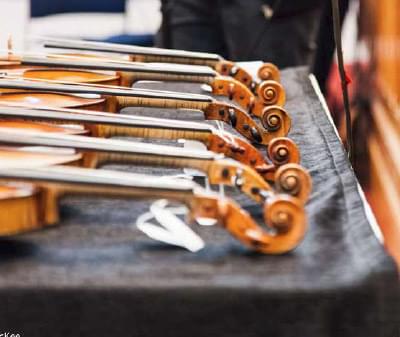Notable Sales: Francesco Stradivari
Giacomo Francesco, known as Francesco Stradivari, was the eldest son of Antonio by his first wife, Francesca. Born in 1671, he is assumed to have worked as his father’s pupil and assistant from an early age, and his own mature hand is detected by experts in instruments dating from around 1707. At this time, work was being done on the design of the new ‘Forma B’ cello model, the first result of which was the ‘Stainlein’ of 1707. Francesco’s handwriting has been speculatively identified on several of the papers and patterns made for this and it may be that he took an important part in developing the design. In Antonio’s will he is the named successor to the house and workshop, and all the tools and materials of the luthier. Most significantly, Antonio additionally states that Francesco ‘has always been, as he presently is, the principal support of the profession of the testator’. He survived his father by only six years, dying unmarried and without known successors in 1743. The property passed to Francesco’s younger brother Paolo, a cloth merchant. The workshop was taken over by Carlo Bergonzi in 1746.
His own labels are very rare. Prior to Antonio’s death neither sons, Francesco nor Omobono are named on labels, although some bear the qualification ‘sotto la disciplina d’Antonio’ (made under the supervision of Antonio). The definitive example of his own labelled and individual work is the 1742 Salabue violin.
(Cremona, b 1671; d 1743)
Giacomo Francesco, known as Francesco Stradivari, was the eldest son of Antonio by his first wife, Francesca. Born in 1671, he is assumed to have worked as his father’s pupil and assistant from an early age, and his own mature hand is detected by experts in instruments dating from around 1707. At this time, work was being done on the design of the new ‘Forma B’ cello model, the first result of which was the ‘Stainlein’ of 1707. Francesco’s handwriting has been speculatively identified on several of the papers and patterns made for this and it may be that he... Read more
19 April 2021 - Dilworth, John
The Evolution of Violin Making from 16th-20th Century Part III
We offer buyers and sellers a bespoke private sale service, sourcing exceptional instruments and bows and matching them with the most discerning buyers.
More InformationTim Ingles and Paul Hayday will offer an initial evaluation of the authenticity and value of your instrument or bow to recommend an auction estimate and reserve price.
Enquire
Tim Ingles and Paul Hayday will offer an initial evaluation of the authenticity and value of your instrument or bow. At this stage, the assessment is free and without obligation. In the first instance, we suggest submitting good-quality images to us, preferably by email to info@ingleshayday.com or by completing the valuation form.
Read more